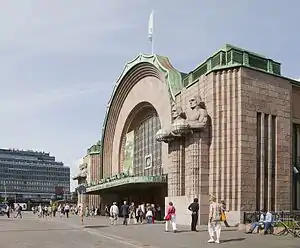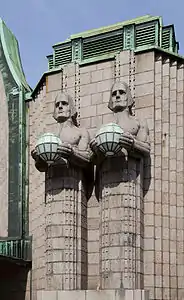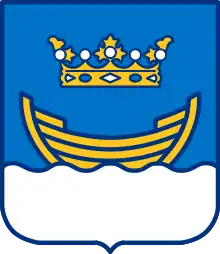Helsinki Central Station
Helsinki Central Station (Finnish: Helsingin päärautatieasema, Swedish: Helsingfors centralstation) (HEC) is the main station for commuter rail and long-distance trains departing from Helsinki, Finland. The station is used by approximately 400,000 people per day, of which about 200,000 are passengers.[1] It serves as the terminus for all trains in the Helsinki commuter rail network, as well as for all Helsinki-bound long-distance trains in Finland. The Central Railway Station metro station is located in the same building.
Helsinki Helsingfors | ||||||||||||||||||||||||||||||||||||||||||||||||||||||||||||||||||||||||||||||||||||||||||||||
|---|---|---|---|---|---|---|---|---|---|---|---|---|---|---|---|---|---|---|---|---|---|---|---|---|---|---|---|---|---|---|---|---|---|---|---|---|---|---|---|---|---|---|---|---|---|---|---|---|---|---|---|---|---|---|---|---|---|---|---|---|---|---|---|---|---|---|---|---|---|---|---|---|---|---|---|---|---|---|---|---|---|---|---|---|---|---|---|---|---|---|---|---|---|---|
| VR long-distance train and HSL commuter rail interchange station | ||||||||||||||||||||||||||||||||||||||||||||||||||||||||||||||||||||||||||||||||||||||||||||||
 | ||||||||||||||||||||||||||||||||||||||||||||||||||||||||||||||||||||||||||||||||||||||||||||||
| Location | Kaivokatu 1 Helsinki Finland | |||||||||||||||||||||||||||||||||||||||||||||||||||||||||||||||||||||||||||||||||||||||||||||
| Coordinates | 60°10′19″N 24°56′29″E | |||||||||||||||||||||||||||||||||||||||||||||||||||||||||||||||||||||||||||||||||||||||||||||
| Owned by | Finnish Transport Agency | |||||||||||||||||||||||||||||||||||||||||||||||||||||||||||||||||||||||||||||||||||||||||||||
| Operated by | VR | |||||||||||||||||||||||||||||||||||||||||||||||||||||||||||||||||||||||||||||||||||||||||||||
| Line(s) | Helsinki–Riihimäki railway Helsinki–Turku railway | |||||||||||||||||||||||||||||||||||||||||||||||||||||||||||||||||||||||||||||||||||||||||||||
| Tracks | 19 | |||||||||||||||||||||||||||||||||||||||||||||||||||||||||||||||||||||||||||||||||||||||||||||
| Connections | M1 M2 Metro station Helsinki tram lines from Rautatieasema 3 5 6 6T 7 9 from Lasipalatsi 1 2 4 10 Helsinki Buses | |||||||||||||||||||||||||||||||||||||||||||||||||||||||||||||||||||||||||||||||||||||||||||||
| Construction | ||||||||||||||||||||||||||||||||||||||||||||||||||||||||||||||||||||||||||||||||||||||||||||||
| Structure type | Ground station | |||||||||||||||||||||||||||||||||||||||||||||||||||||||||||||||||||||||||||||||||||||||||||||
| Other information | ||||||||||||||||||||||||||||||||||||||||||||||||||||||||||||||||||||||||||||||||||||||||||||||
| Station code | Hki | |||||||||||||||||||||||||||||||||||||||||||||||||||||||||||||||||||||||||||||||||||||||||||||
| IATA code | HEC | |||||||||||||||||||||||||||||||||||||||||||||||||||||||||||||||||||||||||||||||||||||||||||||
| Fare zone | A | |||||||||||||||||||||||||||||||||||||||||||||||||||||||||||||||||||||||||||||||||||||||||||||
| History | ||||||||||||||||||||||||||||||||||||||||||||||||||||||||||||||||||||||||||||||||||||||||||||||
| Opened | 1862 (originally) 1919 (current building) | |||||||||||||||||||||||||||||||||||||||||||||||||||||||||||||||||||||||||||||||||||||||||||||
| Rebuilt | 1909 | |||||||||||||||||||||||||||||||||||||||||||||||||||||||||||||||||||||||||||||||||||||||||||||
| Electrified | Yes | |||||||||||||||||||||||||||||||||||||||||||||||||||||||||||||||||||||||||||||||||||||||||||||
| Passengers | ||||||||||||||||||||||||||||||||||||||||||||||||||||||||||||||||||||||||||||||||||||||||||||||
| about 200,000 daily | ||||||||||||||||||||||||||||||||||||||||||||||||||||||||||||||||||||||||||||||||||||||||||||||
| ||||||||||||||||||||||||||||||||||||||||||||||||||||||||||||||||||||||||||||||||||||||||||||||
| ||||||||||||||||||||||||||||||||||||||||||||||||||||||||||||||||||||||||||||||||||||||||||||||
| Location | ||||||||||||||||||||||||||||||||||||||||||||||||||||||||||||||||||||||||||||||||||||||||||||||
.svg.png.webp) Helsinki Central The location of the station in Helsinki. | ||||||||||||||||||||||||||||||||||||||||||||||||||||||||||||||||||||||||||||||||||||||||||||||
The station building was designed by Eliel Saarinen and inaugurated in 1919. Helsinki Central was chosen as one of the world's most beautiful railway stations by BBC in 2013.[2]
History

Helsinki's first railway station was built in 1862 to accommodate trains on the Helsinki-Hämeenlinna line, päärata. The station's plans were drawn by Swedish architect Carl Albert Edelfelt. However, as the popularity of railways grew, the station turned out to be too small, and a contest was organised in 1904 with the intention of producing plans for a new station. The contest received 21 entries, and was won by Eliel Saarinen, with a pure national romanticist design, which sparked off a vigorous debate about the architecture of major public buildings, with demands for a modern, rational style. Saarinen himself abandoned romanticism altogether and re-designed the station completely. The new design was finished in 1909 and the new station building was opened in 1919.
President Kyösti Kallio died at the station on 19 December 1940 of a heart attack while going back home to Nivala after having retired as president. Legend says he died in the arms of Carl Mannerheim.
The clock tower side of the station was damaged in a fire on 14 June 1950.[3]
In the 1960s, the underground Asematunneli pedestrian underpass and underground shopping centre complex was built south of the station. The first surveillance cameras in the station hall were installed in the spring of 1968.[4]
The first electric train arrived at the station on 13 January 1969. After testing, regular electric train traffic was started between Helsinki and Kirkkonummi on 26 January 1969.[5][6]
The Rautatientori metro station, connected to the railway station via Asematunneli, was built part of the Helsinki Metro construction work. It was one of the original metro stations, as it was opened in 1982.
In 2000, a glass roof, which had already been in the original drawings by Eliel Saarinen, was built over the railway station's central platforms, although to a new design. In 2003, the shopping wing Kauppakuja was opened along with a hotel.
The area between the Parliament House and the station contained the VR warehouses, a rail-freight complex. Its original use had long been discontinued in 2006, when it was torn down to make space for the Helsinki Music Centre.
One of the tracks branching to the west just before the central station bypassed the warehouses. It was a freight route, the Helsinki harbour rail, which passed through the inner west side of the city, all the way around the Helsinki peninsula to Katajanokka. Later most of it was closed, and the track only led to the West Harbour. This last section was discontinued in 2009, when sea freight operations were moved to the new Vuosaari Harbour from old harbours near the city centre. Its right-of-way was converted into a pedestrian and bicycle route.
On 7 June 2010, the station was officially renamed Helsingin päärautatieasema-Helsingfors centralstation (Helsinki main, or central, railway station, in Finnish and Swedish), replacing the previous official name Helsingin rautatieasema-Helsingfors järnvägsstation (Helsinki railway station). The Finnish transport bureau uses "Helsinki C" as a shorthand, and there were erroneous news reports that this shorthand would also be taken into official use. Turku Central Station was renamed in a similar manner.[7]
Presidential lounge

Helsinki Central houses a private 50-square-metre (540 sq ft) waiting lounge exclusively for the use of the President of Finland and his or her official guests. The lounge, featuring furniture designed by Eliel Saarinen, has two entrances, a bigger one leading in from Rautatientori Square and a smaller one leading in from the main station hall. The lounge was completed in 1911 and was originally intended for the private use of the Emperor of Russia,[8] but the First World War delayed its official inauguration to 1919, at which point it had been converted into a temporary military hospital, and was afterwards given to the use of the Finnish President.
Features
The station is mostly clad in Finnish granite,[9] and its distinguishing features are its clock tower and the two pairs of statues holding the spherical lamps, lit at night-time, on either side of the main entrance. Animated characters based on the statues have recently been featured in some major advertising campaigns by Finland's government-owned railway operator VR, to the extent of releasing rap singles allegedly sung by Kivimiehet ("The stone men").
There are 19 platforms at the station. Platforms 1–3 are on the east side and serve local trains on the Tikkurila route, their tracks stop short of the main station roof. Platforms 4–11, which accommodate long-distance trains, are physically within the station building. Platforms 5–10 serve trains running via Tikkurila to Tampere, St Petersburg and other points north and east, platforms 11 and 12 serve express trains via the Espoo line to Turku. Platforms 12–19, which do not stretch to the building itself, are on the west side and serve local trains on the Leppävaara and Kehärata routes. The tracks funnel into separate express and local tracks for both the Espoo and the Tikkurila routes with the express tracks in the middle and the local tracks on the outside, aligning with their respective platforms. This gives eight principal tracks but there is an additional ninth express track for the Tikkurila route out through the Pasila station, the first stop out, about five minutes or 3 km north of Central.
Helsinki Central serves as a hub for Finnish transport. There are many platforms for local buses on both the west and the east sides of the main station building. The Helsinki Metro Central Railway Station metro station is located under the main station building, linked through Asematunneli, which has entrances in the main hall of the station and at various points in the surrounding streets. The majority of Helsinki's tram routes pass in front of or to the west of the station. The Helsinki central bus station is located at Kamppi Center, about 400 m, or one metro stop, to the west of the railway station.
Although the Helsinki Airport is reachable from the station by the I/P commuter rail service, there is also regular bus connections between the station and the airport: two regional buses operated by HSL, and a private express coach operated for Finnair.
Incidents and accidents
Over the years, there have been a few incidents at Helsinki Central. However, no lives have been lost as a result :[10]
- 28 August 1926: a passenger train (pulled by Hv2 674) crashed into the passenger hall. 18 were injured.
- 23 October 1944: a passenger train from Turku crashed through a buffer stop. The locomotive ended in the outer hall of the station.
- 5 October 1990: a runaway freight train crashed into the building. Two wagons ended in the passenger hall and many others ended on the platforms.[11]
4 January 2010 accident

On 4 January 2010, four empty passenger carriages overran the buffers of platform 13. The carriages had broken free of their train during a shunting manoeuvre and ran under gravity down the gentle hill from Linnunlaulu before being diverting into an empty platform and impacting the buffers at 20–30 kilometres per hour.[12]
The eight-carriage train arriving from the depot had been due to form the 08:12 departure running from Helsinki to Kajaani, through central Finland via Lahti and Kuopio.[12][13][14] The formation which broke away consisted of three double-decker "Intercity 2" carriages, followed by a single-decker restaurant car.[15] The runaway carriages were quickly detected and deliberately routed into one of the shorter commuter platforms (fitted with large concrete barriers beyond the buffers[13]) in order to minimise damage to the main station area.[15] Passengers aboard an adjacent commuter train waiting to depart were ordered to leave their train and run away from the area and announcements were made over the station's loudspeaker system. The first carriage of the four runaway cars mounted the concrete barrier. Members of the public in an Ernst & Young office beyond the end of the platform and those in the Holiday Inn hotel above the platforms all escaped without injury. The first carriage then struck the hotel's conference room,[16] causing extensive damage to the room.[17] The conductor aboard the train as it came in sustained light injuries to their arm,[13] with nobody else injured.[18][19]
Services had resumed—at a reduced level by the afternoon—following repairs to damage to the overhead line.[20] The Finnish Accident Investigation Board announced that they would proceed with an investigation into why the brakes had not automatically applied.[12] A restaurant car and one of the passenger carriages were towed to the depot by a diesel locomotive during the course of the night,[15] after which the front carriage was partially dragged back out of the hotel building.[21] The building that had taken the force of the crash was deemed to be structurally sound.[22]
On 18 January 2010 the Finnish Accident Investigation Board made available their interim report which concluded that the incident had been caused by a combination of bad weather and then human error. Initially, snow and ice had caused the front carriages to detach from the rest of the train; followed by the guard having released the brakes manually—not realizing that the two halves of the train were no longer coupled.[23]
Gallery
 Helsinki Central's tower.
Helsinki Central's tower. Statues at the station
Statues at the station The metro station can be accessed through the Asematunneli complex
The metro station can be accessed through the Asematunneli complex The main entrance on Kaivokatu.
The main entrance on Kaivokatu. InterCity 2 trains under the glass ceiling
InterCity 2 trains under the glass ceiling The former ticket hall in the Helsinki Central railway station, later converted into an Italian restaurant.
The former ticket hall in the Helsinki Central railway station, later converted into an Italian restaurant. Scale 1:10 model of VR Class Hr1 1001 in the ticket hall of Helsinki Central Station
Scale 1:10 model of VR Class Hr1 1001 in the ticket hall of Helsinki Central Station
See also
Bibliography
- Högström, Hilkka (1996). Helsingin rautatieasema [Helsinki railway station]. Helsinki. ISBN 951-53-0533-0.
References
- "Rautatieasema". Visit Helsinki : Helsingin kaupungin virallinen matkailusivusto (in Finnish). 2011-11-08. Retrieved 2017-12-02.
- Jonathan Glancey (December 3, 2013). "Ten of the world's most beautiful railway stations". BBC. Retrieved February 14, 2014.
- Vierivät kivet 3 February 2004
- Helsingin Sanomat 15 January 1969, p.14.
- Helsingin Sanomat 14 January 1969 p. 11
- Helsingin Sanomat 27 January 1969 p. 3.
- Helsingin rautatieasemasta ei tulekaan Helsinki C, Helsingin Sanomat online edition, 3 June 2010. Accessed 3 June 2010.
- http://helsinkithisweek.com/articles/helsinki-places-central-railway-station
- Glancey, Jonathan. "Ten of the world's most beautiful railway stations". Retrieved 2017-11-19.
- Valonen, Kai (2000). Raideliikenneonnettomuuksien tutkinta – kansainvälinen vertailu [Investigation of Rail Accidents – International Comparison] (PDF) (Master's thesis, Helsinki University of Technology, mechanical engineering) (in Finnish). Kai Valonen. Retrieved 18 April 2010.
- Juhana Hietaranta. "Tavarajunan törmääminen Helsingin asemaan 5.10.1990" [The freight train crash at Helsinki central station on 5 Oct 1990] (in Finnish). Seisake.net. Retrieved 18 April 2010.
- "Train crashes into hotel at Helsinki's Central Railway Station". Helsingin Sanomat. 2010-01-04. Archived from the original on 2010-01-07. Retrieved 2010-01-04.
- "Runaway Train Carriages at Helsinki Railway Station". YLE News. 2010-01-04. Retrieved 2010-01-04.
- "Helsinki–Kuopio–Oulu" (PDF). Timetables. VR Group. 2009-11-04. p. 1.
IC71, Helsinki 8.12, Lahti 9.08, Kuopio 12.47, Kajaani 14.40
- "Runaway Intercity coaches back on the track after crash in Helsinki". Helsingin Sanomat. 2010-01-05. Archived from the original on 2010-01-09. Retrieved 2010-01-05.
- Press Association (2010-01-04). "Finnish train crashes into hotel". United Kingdom: Google News. Retrieved 2010-01-04.
- Aimo-Koivisto, Antti (2010-01-04). "Runaway carriages plough into hotel in central Helsinki". Helsinki Times. Retrieved 2010-01-04.
- "Train crashes into hotel at Helsinki Railway Station" (Video). BBC News Online. 2010-01-04. Retrieved 2010-01-04.
- "Empty train crashes into rail station in Helsinki" (Video). ITN News. United Kingdom: Youtube. 2010-01-04. Retrieved 2010-01-04.
- "Home". VR Group. Archived from the original on 2010-03-04. Retrieved 2010-01-04.
Rail services have resumed in Helsinki. Rail services were disrupted due to an accident. Overhead wires were damaged when empty coaches collided with the platform. The accident did not cause any injuries. Delays and service alterations are expected in train services during this evening.
- Nukari, Jussi (2010-01-05). "Runaway railway carriage removed from Helsinki hotel building". Helsinki Times. Retrieved 2010-01-05.
- "Runaway Train Back on Track" (Video). YLE News. 2010-01-05. Retrieved 2010-01-05.
- Finnish News Agency (2010-01-18). "Railway guard overrode Helsinki accident carriages' brakes -AIB". Helsinki Times. Retrieved 2010-02-06.


